A few years ago, Corbin Spitzer from Spitzer Associates (Houston, Texas) correctly challenged a view in my article "10 Steps to Proper Alignment" (Pumping Prescriptions, October 2005). Spitzer criticized my recommendation of leaving the alignment shims in the grout. As Spitzer put it, "The use of wedges or shims for vertical alignment is not an acceptable method by today's standards. Wedges and shims create point loading that can lead to vibration problems. When wedges or shims are grouted in and the anchor bolts are tensioned, the point loading does not allow the clamping load to be spread across the grout to the baseplate mating surface." However, many still follow the old method of leaving the shims in, despite all reasons against it.
I was recently asked to consult a high rise building complex on a cooling water pump noise problem. The initial reason for the study was a complaint from apartment residents to building maintenance of a humming noise emanating from behind the apartment walls.
In response to the request, we first conducted a review of the installation, listening to the noise at the pump room level, then at the apartments and then at the roof area. Vibration analysis was performed at the condenser pumps and cooling tower pumps, including overall magnitude and full spectral FFT vibration signature analysis.
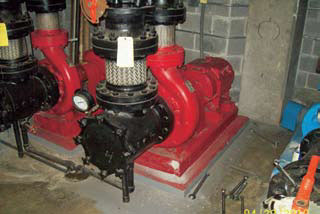
Figure 1
Vibration measurements were taken at various places in the system, including pumps, motors, piping and baseplates. Spectral analysis indicated the overall values of vibrations were relatively small, but significant enough to possibly result in amplification if bases were not properly attached. The highest vibration was recorded in the vertical direction for the pump and motor bearing areas. The main vibration components were at the running speed (1,760 rpm) and at the 5X multiple (8,850 rpm), which was likely the impeller vane pass frequency.
The vertical direction of the maximum vibration suggested the presence of a loose connection between the pump feet and baseplate, or the attachment of the baseplate itself to the foundation. A more detailed review of the attachments was then performed, which revealed the following issues:
- Incorrect grouting of the baseplates
- Incorrect attachment of the pump and motor to the base
- Inadequate design of the baseplate
As you can see in the photos, the most significant effect on the issue was (a), while (b) and (c) had a contributing effect.
As can be seen in Figures 2 and 3, the major error was to use a nut below the base, directly on the anchor bolt, as a leveling shim.
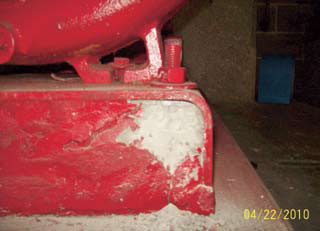
Figure 2
Note that the upper nut was unable to tension the anchor bolts restricted by the bottom nut. Any further torqueing of the upper nut would result in a tighter squeeze of the plate between the nuts, but not the tightening of the baseplate to the grout as intended. Application of the grout in this case was completely useless.
The bottom nut prevented the top nut from properly applying tension to the anchor bolt, which essentially remained completely unstressed, with poor contact and pressure evenly distributed between the bottom of the baseplate and the grout. Installers commonly make this error, as noted by Corbin Spitzer.
With the baseplate essentially sitting with no pressure applied to the grout, it resonates in response to even small vibration forces. These noises may go unnoticed at a refinery or paper mill, but they are not acceptable for apartment residents trying to sleep.
As an additional test, the motor was decoupled from the pump and operated by itself. The noise remained, confirmed by switching the motor off and on. These vibrations were transmitted from the motor to the base, the base to the pump, to the connected piping and foundation and resonated through the building.
The bolts attaching the pumps to the base penetrated through the baseplate and were cemented in the grout. Using tubing to attach the pumps was also not helping.
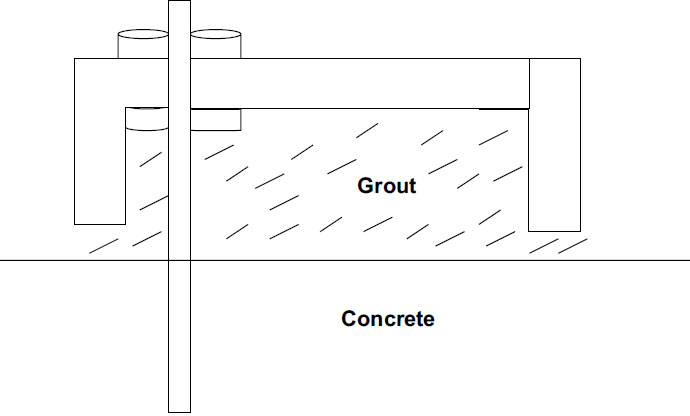
Figure 3
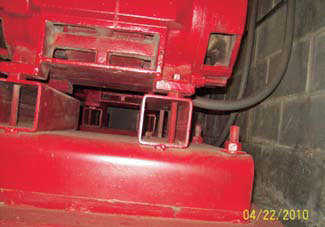
Figure 4
A stiffer (thick) shim (bar) should typically be used, with smaller (0.010 to 0.001 in.) sets to make up the final difference of adjustment; these shims should also be wide enough to sit under the entire surface of the foot. Notice the improper use of a small nut between the bottom of the foot and the channel; this poor connection lacks a good contact between the entire surface of the foot and a shim.
Whoever did the grouting job before must have been a telephone pole expert, as the static structures are grouted in this way (see Figure 5 and 6).
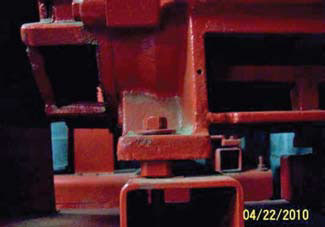
Figure 5
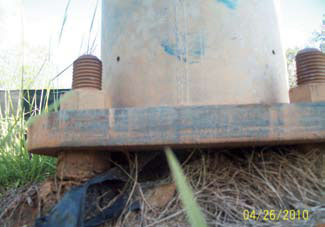
Figure 6
The telephone pole is sandwiched between the two nuts, which could be used as leveling device. However, I have not seen telephone poles jumping around too much, nor have I heard of vibration analysis applied to solve telephone pole vibration problems. Applying the art of grouting telephone poles to pumps could get you in trouble. It is better to follow proper installation techniques for rotating machinery.
A parting quiz: Is there any part of the bolt that is allowed to come in contact with the grout? The correct answer gets you free admission to the seventh annual PumpTec Conference in Atlanta in September.
Additional Information
Many other field installation experts have addressed the subject of alignment shims in the grout, including Malcolm Murray (“Flange Fitup Problems?,” Maintenance, January 1980) and Perry Monroe (“The Road to Reliable Pumps,” 22nd International Pump Symposium, Tutorial, 2005).

